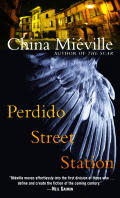
| Series: | New Crobuzon #1 |
| Publisher: | Del Ray |
| Copyright: | 2000 |
| Printing: | August 2003 |
| ISBN: | 0-345-45940-7 |
| Format: | Mass market |
| Pages: | 623 |
At its roots, I'm convinced that this is a horror novel. All the ingredients are there: terrifying creatures released by man's ignorance to prey on unsuspecting innocents, heart-stopping moments face to face with nightmarish evil, collisions of powers hovering just at the edge of human comprehension, vicious and unfair moments of near-random violence that leaves wounds that cannot ever be healed, and no clean answers, easy escapes, or actions without cost. Perdido Street Station is, in fact, unremittingly dark, enough that it made me somewhat nervous to read it just before falling asleep.
How China Miéville manages to build upon that foundation a beautifully constructed science fiction novel while still approaching the "feel" of the genre from entirely unexpected directions I could not tell you, but it is a truly beautiful thing to watch happen.
That is, perhaps, the only thing in this book that could be called beautiful. Fetid, polluted, slime-covered, and putrid, New Crobuzon, the setting and best supporting character of the book, is thoroughly dystopian. Every surface seems covered in an unremitting layer of grime so evocative and well-described that one can almost smell it.
The river twists and turns to face the city. It looms suddenly, massive, stamped on the landscape. Its light wells up around the surrounds, the rock hills, like bruise-blood. Its dirty towers glow. I am debased. I am compelled to worship this extraordinary presence that has silted into existence at the conjunction of two rivers. It is a vast pollutant, a stench, a klaxon sounding. Fat chimneys retch dirt to the sky even now in the deep night. It is not the current which pulls us, but the city itself, its weight sucks us in. Faint shouts, here and there the calls of beasts, the obscene clash and pounding from the factories as huge machines rut. Railways trace urban anatomy like protruding veins. Red brick and dark walls, squat churches like troglodytic things, ragged awnings flickering, cobbled mazes in the old town, culs-de-sac, sewers riddling the earth like secular sepulchures, a new landscape of wasteground, crushed stone, libraries fat with forgotten volumes, old hospitals, towerblocks, ships and metal claws that lift cargos from the water.
I could see the city unfold with the story, as if I were reading a graphic novel. The construction of a sense of place is astonishing, particularly since the narrative almost never lapses into extended description. The surroundings permeate the story, growing through the cobblestones of the plot.
While the world-building shines through the horror trappings, the plot demonstrates what one gets when one takes a science fiction approach to a horror novel without blunting the horror, namely an exquisite blending of the terror of the unknown and unthinkable with a growing sense of wonder at the edges of the known. Miéville's characters are not afraid to ask what and why, and Miéville, more impressively, is not afraid to give them answers. They plumb intuitive depths of half-magical steampunk science, tackle horrific problems with stubborn engineering, and achieve a growing understanding of exactly what it is that they're facing, how it came about, and what they can do about it. This, a trademark of the science in science fiction, is exactly what horror often cannot afford to do, relying on the fear produced by the incomprehensible. Somehow, Miéville pulls it off, never cheapening either the terror or the quest for understanding.
Perdido Street Station is not a fast read. It starts slow, the writing is rich and layered and demands attention, and I found I was reading it about half as fast as I would normally read a novel. This is a book for which you have to put aside some time to immerse yourself; there are so many things going on at once that I can only touch on a small percentage of them. No less than eight non-human races are lovingly or horrifically described. A political structure is built with depths that are only hinted at. Everywhere through the fabric of the city the story winds, there are inhabitants going about their very different lives, history buried in the mud, marvels of architecture half-forgotten or remade, and individuals who seem on the verge of suddenly revealing stories of their own. It can be chaotic at times, with the background nearly overwhelming the plot, but at the end I felt like I had an understanding of how New Crobuzon felt that went deeper than words.
I will warn that there are no pat conclusions here and no simple triumphs. This is one of the darkest novels that I've ever read, so beware if you want your endings happy and your resolutions clean. If you have the stomach for this style of writing, though, you will be hard-pressed to find a better book.
Followed by The Scar.
Reviewed: 2004-09-06